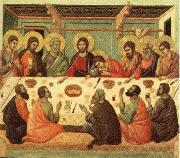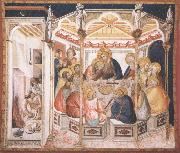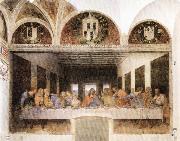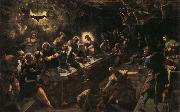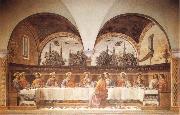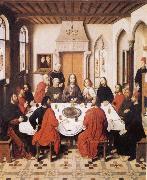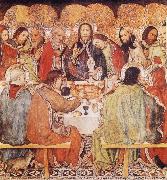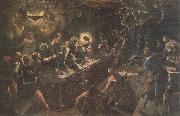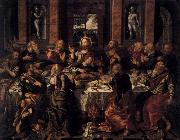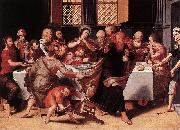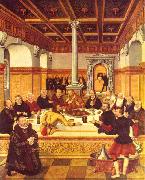Wholesale Oil Painting No Minimum |
|||||||||||
|
|
|||||||||||

|
|||||||||||
|
|
|
||||||||
Jaime Huguet1415-1492 French Jaime Huguet Galleries |
||||||||
|
|
||||||||
Last Supper
Last Supper Painting ID:: 2261 |
Museo de Arte de Cataluna, Barcelona Museo de Arte de Cataluna, Barcelona |
|||||||
|
|
||||||||
Duccio di Buoninsegna1255-1318 Italian Duccio di Buoninsegna Locations Italian painter. He was one of the most important painters of the 14th century and like his slightly younger contemporary, Giotto, was a major influence on the course of Italian painting. An innovator, he introduced into Sienese painting new altarpiece designs, a dramatic use of landscape, expressive emotional relationships, extremely complex spatial structures and a subtle interplay of colour. His most important and revolutionary work, the Maeste for Siena Cathedral, was never matched during the 14th century, if at all, and his influence lasted well into the 15th century. |
||||||||
|
|
||||||||
|
|
Last Supper
Last Supper Painting ID:: 30390 |
mk68
Tempera on wood
Siena
Opera del Duomo Museum
mk68 Tempera on wood Siena Opera del Duomo Museum |
||||||
|
|
||||||||
Pietro LorenzettiItalian Byzantine Style Painter, ca.1280-1348 |
||||||||
|
|
||||||||
|
|
Last Supper
Last Supper Painting ID:: 30394 |
mk68
Fresco
8x10
Assisi
Church of San Francesco
mk68 Fresco 8x10 Assisi Church of San Francesco |
||||||
|
|
||||||||
Andrea del CastagnoItalian c1421-1457 Andrea del Castagno Location Italian c1421-1457 Andrea del Castagno Location Italian painter. He was the most influential 15th-century Florentine master, after Masaccio, of the realistic rendering of the figure and the representation of the human body as a three-dimensional solid by means of contours. By translating into the terms of painting the statues of the Florentine sculptors Nanni di Banco and Donatello, Castagno set Florentine painting on a course dominated by line (the Florentine tradition of disegno), the effect of relief and the sculptural depiction of the figure that became its distinctive trait throughout the Italian Renaissance, a trend that culminated in the art of Michelangelo. |
||||||||
|
|
||||||||
|
|
Last Supper
Last Supper Painting ID:: 30416 |
mk68
Fresco,width of wall
Florence
Convent of Sant'Apollonia
1447
ltaly
mk68 Fresco,width of wall Florence Convent of Sant'Apollonia 1447 ltaly |
||||||
|
|
||||||||
LEONARDO da VinciItalian High Renaissance Painter and Inventor, 1452-1519 Italian High Renaissance Painter and Inventor, 1452-1519 Florentine Renaissance man, genius, artist in all media, architect, military engineer. Possibly the most brilliantly creative man in European history, he advertised himself, first of all, as a military engineer. In a famous letter dated about 1481 to Ludovico Sforza, of which a copy survives in the Codice Atlantico in Milan, Leonardo asks for employment in that capacity. He had plans for bridges, very light and strong, and plans for destroying those of the enemy. He knew how to cut off water to besieged fortifications, and how to construct bridges, mantlets, scaling ladders, and other instruments. He designed cannon, very convenient and easy of transport, designed to fire small stones, almost in the manner of hail??grape- or case-shot (see ammunition, artillery). He offered cannon of very beautiful and useful shapes, quite different from those in common use and, where it is not possible to employ cannon ?? catapults, mangonels and trabocchi and other engines of wonderful efficacy not in general use. And he said he made armoured cars, safe and unassailable, which will enter the serried ranks of the enemy with their artillery ?? and behind them the infantry will be able to follow quite unharmed, and without any opposition. He also offered to design ships which can resist the fire of all the heaviest cannon, and powder and smoke. The large number of surviving drawings and notes on military art show that Leonardo claims were not without foundation, although most date from after the Sforza letter. Most of the drawings, including giant crossbows (see bows), appear to be improvements on existing machines rather than new inventions. One exception is the drawing of a tank dating from 1485-8 now in the British Museum??a flattened cone, propelled from inside by crankshafts, firing guns. Another design in the British Museum, for a machine with scythes revolving in the horizontal plane, dismembering bodies as it goes, is gruesomely fanciful. Most of the other drawings are in the Codice Atlantico in Milan but some are in the Royal Libraries at Windsor and Turin, in Venice, or the Louvre and the École des Beaux Arts in Paris. Two ingenious machines for continuously firing arrows, machine-gun style, powered by a treadmill are shown in the Codice Atlantico. A number of other sketches of bridges, water pumps, and canals could be for military or civil purposes: dual use technology. Leonardo lived at a time when the first artillery fortifications were appearing and the Codice Atlantico contains sketches of ingenious fortifications combining bastions, round towers, and truncated cones. Models constructed from the drawings and photographed in Calvi works reveal forts which would have looked strikingly modern in the 19th century, and might even feature in science fiction films today. On 18 August 1502 Cesare Borgia appointed Leonardo as his Military Engineer General, although no known building by Leonardo exists. Leonardo was also fascinated by flight. Thirteen pages with drawings for man-powered aeroplanes survive and there is one design for a helicoidal helicopter. Leonardo later realized the inadequacy of the power a man could generate and turned his attention to aerofoils. Had his enormous abilities been concentrated on one thing, he might have invented the modern glider. |
||||||||
|
|
||||||||
|
|
Last Supper
Last Supper Painting ID:: 30446 |
mk68
Tempera
13'9x29'10"
Milan,Convent of Santa
Maria delle Grazie
mk68 Tempera 13'9x29'10" Milan,Convent of Santa Maria delle Grazie |
||||||
|
|
||||||||
Jacopo Tintoretto1518-1594 Italian painter. His father was a silk dyer (tintore); hence the nickname Tintoretto ("Little Dyer"). His early influences include Michelangelo and Titian. In Christ and the Adulteress (c. 1545) figures are set in vast spaces in fanciful perspectives, in distinctly Mannerist style. In 1548 he became the centre of attention of artists and literary men in Venice with his St. Mark Freeing the Slave, so rich in structural elements of post-Michelangelo Roman art that it is surprising to learn that he had never visited Rome. By 1555 he was a famous and sought-after painter, with a style marked by quickness of execution, great vivacity of colour, a predilection for variegated perspective, and a dynamic conception of space. In his most important undertaking, the decoration of Venice's Scuola Grande di San Rocco (1564 ?C 88), he exhibited his passionate style and profound religious faith. His technique and vision were wholly personal and constantly evolving. |
||||||||
|
|
||||||||
|
|
Last Supper
Last Supper Painting ID:: 30530 |
mk68
Oil on canvas
12'x8'7"
Venice
Church of San Giorgio Maggiore
1592-1594
Italy
mk68 Oil on canvas 12'x8'7" Venice Church of San Giorgio Maggiore 1592-1594 Italy |
||||||
|
|
||||||||
Joan de JoanesSpanish Painter 1507-1579 |
||||||||
|
|
||||||||
|
|
Last Supper
Last Supper Painting ID:: 32868 |
mk84
ca.1560
Madrid,
Prado
Panel
116x119cm
mk84 ca.1560 Madrid, Prado Panel 116x119cm |
||||||
|
|
||||||||
Alonso VazquezSpanish ?-1608 was a Spanish sculptor and painter of the Renaissance period. Vazquez was born in Ronda, and learned painting in the school of Arfian at Seville. He passed through the usual apprenticeship of painting "sargas" and at length painted frescoes and oil-pictures. For the Cathedral and the convents of St. Francis and St. Paul, he painted a variety of works, no longer extant. He painted a series of canvases on the life of St. Raymond, for the cloister of the friars of the order of Mercy. Vazquez was one of the artists chosen by the city of Seville to paint the great catafalque erected in the Cathedral, at the time of public mourning for the death of Philip II. He died either in Seville or in Mexico, |
||||||||
|
|
||||||||
|
|
Last Supper
Last Supper Painting ID:: 32884 |
mk84
1588-1603
Seville,Museo de Bellas Artes
mk84 1588-1603 Seville,Museo de Bellas Artes |
||||||
|
|
||||||||
GHIRLANDAIO, DomenicoItalian Early Renaissance Painter, 1449-1494 Florentine painter, whose family name was Bigordi. He may have studied painting and mosaics under Alesso Baldovinetti. Ghirlandaio was an excellent technician. Keenly observant of the contemporary scene, he depicted many prominent Florentine personalities within his religious narrative paintings. Among his earliest frescoes are the Madonna with the Vespucci Family and the Last Supper (Church of the Ognissanti, Florence). He painted scenes from the life of Santa Fina (collegiate church in San Gimigniano) and frescoes in the Palazzo Vecchio, Florence. In 1481, Pope Sixtus IV called him to Rome, along with Botticelli, to decorate the Sistine Chapel. He painted the Calling of the First Apostles, a scene close in spirit to Masaccio. He returned to Florence to work on the frescoes in the Sassetti Chapel in Santa Trinita. He introduced Sassetti, Corsi, Poliziano, the Medici, and many other contemporaries as participants in the life of St. Francis. Ghirlandaio's most famous achievement is his fresco cycle of the life of Mary and St. John the Baptist for the choir of Santa Maria Novella. Michelangelo served an apprenticeship with him at this time and probably worked on these frescoes. Other examples of his art are the Adoration of the Magi (Uffizi); another Adoration (Hospital of the Innocents); a mosaic of the Annunciation for the Cathedral; a portrait of Francesco Sassetti and his son (Metropolitan Mus.); |
||||||||
|
|
||||||||
|
|
Last Supper
Last Supper Painting ID:: 33394 |
mk86
1480
Fresco,total width 812cm
Florence,Convent of San Marco.Refectory
mk86 1480 Fresco,total width 812cm Florence,Convent of San Marco.Refectory |
||||||
|
|
||||||||
Dieric Bouts1420-1475 Flemish Dieric Bouts Locations Dirk Bouts whose real name was Theodorik Romboutszoon, was probably born in Haarlem, where he may have studied under the painter Albert van Ouwater. Sometime before 1450 Bouts took up residence in the Flemish city of Louvain. His name appeared in the records of Louvain in 1457 and again in 1468, when he was appointed "city painter." It is likely that Bouts spent some time in Bruges, as his earliest work, the Infancy Altarpiece shows the distinct and strong influence of Petrus Christus, the leading master of that city after the death of Jan van Eyck. The slightly later Deposition Altarpiece (ca. 1450) displays strong connections with the style of Rogier van der Weyden in both the figure types and the composition. About 1460, the period of the Entombment in London, the early, formative influence of Petrus Christus had been almost totally displaced by that of Rogier, though Bouts personal vision began to emerge in the fluid and continuous landscape background. The great Last Supper Altarpiece (1464-1467) marks the high point of Bouts career. In this solemn and dignified masterpiece the painter achieved spiritual grandeur in the context of convincing physical reality. The central panel of the altarpiece is the most emphatically significant treatment of the theme of the Last Supper in Northern European art. The wings, which contain Old Testament prefigurations of the central theme, are freer and more loosely organized. Eschewing the symmetry and rigid axial construction of the main panel, Bouts produced rhythmic foreground compositions in combination with fluid and dramatic spatial recessions. In 1468 Bouts was commissioned to paint four panels on the subject of justice for the Town Hall of Louvain. At the painter death in 1475 only two of the paintings had been completed; they are among the most remarkable productions of his career. The unusual subjects, taken from the chronicles of a 12th-century historian, concern the wrongful execution by Emperor Otto III of one of his counts and the subsequent vindication of the nobleman by his wife. The finer of the panels represents the dramatic trial by fire which the wife was obliged to undergo to prove her husband innocence. Rich draperies and sumptuous colors are applied to tall angular forms to create a work of rare formal elegance and high decorative appeal. In order to dignify the event, however, the artist has employed restrained gestures and expressions as well as a completely rationalized spatial setting. As in the Last Supper Altarpiece, a sense of solemn and hieratic importance is expressed by means of an austere and rigid geometry in the construction of both persons and places. The late productions of Bouts workshop, such as the well-known Pearl of Brabant Altarpiece, are characterized by the close collaboration of the painter two sons, Dirk the Younger (1448-1491) and Aelbrecht (1455/1460-1549). In the paintings of his less gifted sons, the master distinctive figure style was appreciably altered, though Dirk the Younger appears to have retained much of his father sensitivity to the landscape. In addition to his innovations in the depiction of landscape, Bouts made a substantial contribution to the development of the portrait. His Portrait of a Man (1462) localizes the sitter in an enlarged architectural setting while permitting the interior space to merge with the exterior through an open window. For the first time in Northern painting a common bond was forged between a particularized individual and the universal world of nature. |
||||||||
|
|
||||||||
|
|
Last Supper
Last Supper Painting ID:: 33434 |
mk86
1464-1467
Tempera on wood
180x150cm
Louvain,Sankt Peter
mk86 1464-1467 Tempera on wood 180x150cm Louvain,Sankt Peter |
||||||
|
|
||||||||
Jaume HuguetSpanish Early Renaissance Painter, C.1415-1492 |
||||||||
|
|
||||||||
|
|
Last Supper
Last Supper Painting ID:: 33442 |
mk86
after1450
Tempera on wood
162x170cm
Barcelona,Museu d'Art de Catalunya
mk86 after1450 Tempera on wood 162x170cm Barcelona,Museu d'Art de Catalunya |
||||||
|
|
||||||||
Leonardo Da VinciItalian High Renaissance Painter and Inventor, 1452-1519 Florentine Renaissance man, genius, artist in all media, architect, military engineer. Possibly the most brilliantly creative man in European history, he advertised himself, first of all, as a military engineer. In a famous letter dated about 1481 to Ludovico Sforza, of which a copy survives in the Codice Atlantico in Milan, Leonardo asks for employment in that capacity. He had plans for bridges, very light and strong, and plans for destroying those of the enemy. He knew how to cut off water to besieged fortifications, and how to construct bridges, mantlets, scaling ladders, and other instruments. He designed cannon, very convenient and easy of transport, designed to fire small stones, almost in the manner of hail??grape- or case-shot (see ammunition, artillery). He offered cannon of very beautiful and useful shapes, quite different from those in common use and, where it is not possible to employ cannon ?? catapults, mangonels and trabocchi and other engines of wonderful efficacy not in general use. And he said he made armoured cars, safe and unassailable, which will enter the serried ranks of the enemy with their artillery ?? and behind them the infantry will be able to follow quite unharmed, and without any opposition. He also offered to design ships which can resist the fire of all the heaviest cannon, and powder and smoke. The large number of surviving drawings and notes on military art show that Leonardo claims were not without foundation, although most date from after the Sforza letter. Most of the drawings, including giant crossbows (see bows), appear to be improvements on existing machines rather than new inventions. One exception is the drawing of a tank dating from 1485-8 now in the British Museum??a flattened cone, propelled from inside by crankshafts, firing guns. Another design in the British Museum, for a machine with scythes revolving in the horizontal plane, dismembering bodies as it goes, is gruesomely fanciful. Most of the other drawings are in the Codice Atlantico in Milan but some are in the Royal Libraries at Windsor and Turin, in Venice, or the Louvre and the École des Beaux Arts in Paris. Two ingenious machines for continuously firing arrows, machine-gun style, powered by a treadmill are shown in the Codice Atlantico. A number of other sketches of bridges, water pumps, and canals could be for military or civil purposes: dual use technology. Leonardo lived at a time when the first artillery fortifications were appearing and the Codice Atlantico contains sketches of ingenious fortifications combining bastions, round towers, and truncated cones. Models constructed from the drawings and photographed in Calvi works reveal forts which would have looked strikingly modern in the 19th century, and might even feature in science fiction films today. On 18 August 1502 Cesare Borgia appointed Leonardo as his Military Engineer General, although no known building by Leonardo exists. Leonardo was also fascinated by flight. Thirteen pages with drawings for man-powered aeroplanes survive and there is one design for a helicoidal helicopter. Leonardo later realized the inadequacy of the power a man could generate and turned his attention to aerofoils. Had his enormous abilities been concentrated on one thing, he might have invented the modern glider. |
||||||||
|
|
||||||||
|
|
Last Supper
Last Supper Painting ID:: 33467 |
mk86
1495-1498
Oil tempera on plaster
460x880cm
Milan,Santa Maria delle Grazie,
Refectory
mk86 1495-1498 Oil tempera on plaster 460x880cm Milan,Santa Maria delle Grazie, Refectory |
||||||
|
|
||||||||
LEONARDO da VinciItalian High Renaissance Painter and Inventor, 1452-1519 Italian High Renaissance Painter and Inventor, 1452-1519 Florentine Renaissance man, genius, artist in all media, architect, military engineer. Possibly the most brilliantly creative man in European history, he advertised himself, first of all, as a military engineer. In a famous letter dated about 1481 to Ludovico Sforza, of which a copy survives in the Codice Atlantico in Milan, Leonardo asks for employment in that capacity. He had plans for bridges, very light and strong, and plans for destroying those of the enemy. He knew how to cut off water to besieged fortifications, and how to construct bridges, mantlets, scaling ladders, and other instruments. He designed cannon, very convenient and easy of transport, designed to fire small stones, almost in the manner of hail??grape- or case-shot (see ammunition, artillery). He offered cannon of very beautiful and useful shapes, quite different from those in common use and, where it is not possible to employ cannon ?? catapults, mangonels and trabocchi and other engines of wonderful efficacy not in general use. And he said he made armoured cars, safe and unassailable, which will enter the serried ranks of the enemy with their artillery ?? and behind them the infantry will be able to follow quite unharmed, and without any opposition. He also offered to design ships which can resist the fire of all the heaviest cannon, and powder and smoke. The large number of surviving drawings and notes on military art show that Leonardo claims were not without foundation, although most date from after the Sforza letter. Most of the drawings, including giant crossbows (see bows), appear to be improvements on existing machines rather than new inventions. One exception is the drawing of a tank dating from 1485-8 now in the British Museum??a flattened cone, propelled from inside by crankshafts, firing guns. Another design in the British Museum, for a machine with scythes revolving in the horizontal plane, dismembering bodies as it goes, is gruesomely fanciful. Most of the other drawings are in the Codice Atlantico in Milan but some are in the Royal Libraries at Windsor and Turin, in Venice, or the Louvre and the École des Beaux Arts in Paris. Two ingenious machines for continuously firing arrows, machine-gun style, powered by a treadmill are shown in the Codice Atlantico. A number of other sketches of bridges, water pumps, and canals could be for military or civil purposes: dual use technology. Leonardo lived at a time when the first artillery fortifications were appearing and the Codice Atlantico contains sketches of ingenious fortifications combining bastions, round towers, and truncated cones. Models constructed from the drawings and photographed in Calvi works reveal forts which would have looked strikingly modern in the 19th century, and might even feature in science fiction films today. On 18 August 1502 Cesare Borgia appointed Leonardo as his Military Engineer General, although no known building by Leonardo exists. Leonardo was also fascinated by flight. Thirteen pages with drawings for man-powered aeroplanes survive and there is one design for a helicoidal helicopter. Leonardo later realized the inadequacy of the power a man could generate and turned his attention to aerofoils. Had his enormous abilities been concentrated on one thing, he might have invented the modern glider. |
||||||||
|
|
||||||||
|
|
Last Supper
Last Supper Painting ID:: 38513 |
mk137
1495-1498 oil and Tempera on stone 460x880cm Santa Maria della grace Milan mk137 1495-1498 oil and Tempera on stone 460x880cm Santa Maria della grace Milan |
||||||
|
|
||||||||
Jacopo Tintoretto1518-1594 Italian painter. His father was a silk dyer (tintore); hence the nickname Tintoretto ("Little Dyer"). His early influences include Michelangelo and Titian. In Christ and the Adulteress (c. 1545) figures are set in vast spaces in fanciful perspectives, in distinctly Mannerist style. In 1548 he became the centre of attention of artists and literary men in Venice with his St. Mark Freeing the Slave, so rich in structural elements of post-Michelangelo Roman art that it is surprising to learn that he had never visited Rome. By 1555 he was a famous and sought-after painter, with a style marked by quickness of execution, great vivacity of colour, a predilection for variegated perspective, and a dynamic conception of space. In his most important undertaking, the decoration of Venice's Scuola Grande di San Rocco (1564 ?C 88), he exhibited his passionate style and profound religious faith. His technique and vision were wholly personal and constantly evolving. |
||||||||
|
|
||||||||
|
|
Last Supper
Last Supper Painting ID:: 41184 |
mk157
1592-94
Oil on canvas
365x568cm
mk157 1592-94 Oil on canvas 365x568cm |
||||||
|
|
||||||||
Francisco Goya1746-1828 Goya is considered the 18th Century's foremost painter and etcher of Spanish culture, known for his realistic scenes of battles, bullfights and human corruption. Goya lived during a time of upheaval in Spain that included war with France, the Inquisition, the rule of Napoleon's brother, Joseph, as the King of Spain and, finally, the reign of the Spanish King Ferdinand VII. Experts proclaim these events -- and Goya's deafness as a result of an illness in 1793 -- as central to understanding Goya's work, which frequently depicts human misery in a satiric and sometimes nightmarish fashion. From the 1770s he was a royal court painter for Charles III and Charles IV, and when Bonaparte took the throne in 1809, Goya swore fealty to the new king. When the crown was restored to Spain's Ferdinand VII (1814), Goya, in spite of his earlier allegiance to the French king, was reinstated as royal painter. After 1824 he lived in self-imposed exile in Bordeaux until his death, reportedly because of political differences with Ferdinand. Over his long career he created hundreds of paintings, etchings, and lithographs, among them Maya Clothed and Maya Nude (1798-1800); Caprichos (1799-82); The Second of May 1808 and The Third of May 1808 (1814); Disasters of War (1810-20); and The Black Paintings (1820-23). |
||||||||
|
|
||||||||
|
|
Last Supper
Last Supper Painting ID:: 50702 |
mk214
c.1796-7
Oil on canvas
146x340cm
mk214 c.1796-7 Oil on canvas 146x340cm |
||||||
|
|
||||||||
Andrea del Sartob.July 16, 1486, Florence d.Sept. 28, 1530, Florence Italian Andrea del Sarto Galleries Andrea del Sarto (1486 ?C 1531) was an Italian painter from Florence, whose career flourished during the High Renaissance and early-Mannerism. Though highly regarded by his contemporaries as an artist "senza errori" (i.e., faultless), he is overshadowed now by equally talented contemporaries like Raphael. Andrea fell in love with Lucrezia (del Fede), wife of a hatter named Carlo, of Recanati; the hatter dying opportunely, Andrea married her on 26 December 1512. She has come down to us in many a picture of her lover-husband, who constantly painted her as a Madonna and otherwise; even in painting other women he made them resemble Lucrezia. She was less gently handled by Giorgio Vasari, a pupil of Andrea, who describes her as faithless, jealous, and vixenish with the apprentices; her offstage character permeates Robert Browning's poem-monologue "Andrea del Sarto called the 'faultless painter'" (1855) . He dwelt in Florence throughout the memorable siege of 1529, which was soon followed by an infectious pestilence. He caught the malady, struggled against it with little or no tending from his wife, who held aloof, and he died, no one knowing much about it at the moment, on 22 January 1531, at the comparatively early age of forty-three. He was buried unceremoniously in the church of the Servites. His wife survived her husband by forty years. A number of paintings are considered to be self-portraits. One is in the National Gallery, London, an admirable half-figure, purchased in 1862. Another is at Alnwick Castle, a young man about twenty years, with his elbow on a table. Another youthful portrait is in the Uffizi Gallery, and the Pitti Palace contains more than one. |
||||||||
|
|
||||||||
|
|
Last supper
Last supper Painting ID:: 53234 |
mk228
Oil on canvas
mk228 Oil on canvas |
||||||
|
|
||||||||
Simon Ushakov1626 - 1686) was a leading Russian graphic artist of the late 17th-century. Together with Fyodor Zubov and Fyodor Rozhnov, he is associated with the comprehensive reform of the Russian Orthodox Church undertaken by Patriarch Nikon. We know almost nothing about the early years of Simon Ushakov. His birth date is deduced from his inscription on one of the icons: In the year 7166 painted this icon Simon Ushakov son, being 32 years of age. At 22 he became a paid artist of the Silver Chamber, affiliated with the Armory Prikaz. The bright, fresh colours and exquisite, curving lines of his proto-baroque icons caught the eye of Patriarch Nikon, who introduced Simon to the tsar Alexei Mikhailovich. He became a great favourite with the royal family and was eventually (1664) assigned to the Kremlin Armoury, run by an educated boyar Bogdan Khitrovo. |
||||||||
|
|
||||||||
|
|
Last Supper
Last Supper Painting ID:: 61241 |
Last Supper 1685
Last Supper 1685 |
||||||
|
|
||||||||
BERRUGUETE, AlonsoSpanish Mannerist Painter and Sculptor, ca.1488-1561 Alonso Berruguete was born in Paredes de Navas, Valladolid, the son of Pedro Berruguete, Spain's first major Early Renaissance painter. Pedro was trained in Italy, and it is understandable that he would want his son to have an Italian formation. Alonso was in Florence from about 1504, the year of his father's death, until about 1517. He also spent time in Rome during this period. Berruguete's original purpose was to train as a painter, but he had the opportunity to study sculpture under Michelangelo, whom he is said to have assisted in the execution of some works. Berruguete received minor commissions, such as the completion of paintings and sculptures left unfinished by other artists. On his return to Spain, Berruguete executed an alabaster relief, the Resurrection, for Valencia Cathedral (ca. 1517), which compares favorably with early works by Michelangelo. It is Hellenistic in its anatomical beauty, multiple diagonals, and range of relief projection. The figure of Christ is the climactic center of interest: a vertical, stabilizing force amid a tumult of diagonals described in the agitated movements of the startled Roman soldiers. In 1518 Emperor Charles V named Berruguete court painter. When illness prevented Berruguete from sailing to Germany with Charles V in 1520, the Emperor took it personally and turned a deaf ear to Berruguete's subsequent petitions for commissions. He then returned to his native village until 1523, when Charles V named him a scribe of the criminal section of the Chancery in Valladolid. This gave Berruguete social status, an income, and work he could deputize. Henceforth, he set himself to amass riches and advance socially. He established a studio in Valladolid, hired a number of apprentices, and priced his works above those of all other artists. It was a time of great wealth in Spain; Berruguete had seen sumptuous riches in Italy and was determined to so live that his compatriots would accord him the reverence and acclaim enjoyed by Italian artists. In 1528 Berruguete built himself a palace in Valladolid, opposite the monastery of S. Benito, for which he created his greatest altarpiece. He succeeded so well in his ambitions that in 1542 he sold the Emperor's benefice for 4,000 ducats. Two years before he died, he became a squire when the regent of Portugal, Princess Juana, gave him the village of Ventosa with its 120 inhabitants. |
||||||||
|
|
||||||||
|
|
Last Supper
Last Supper Painting ID:: 62313 |
1588-1603 Oil on canvas Museo de Bellas Artes, Seville In addition to Italian influences, the impact of northern painters, such as Marten de Vos and Maerten van Heemskerck, on painters in Seville at the end of the 16th century was important. The resulting hybrid of Italian and Flemish elements became the dominant mode of expression until well into the seventeenth century and is first observable in the work of Alonso V?zquez, who worked in Seville from 1588 until his departure for Mexico in 1603. His Last Supper, painted for the Carthusians of Santa Maria de las Cuevas, is a pastiche of poses and motifs borrowed from prints by or after Heemskerck, de Vos and Cornelis Cort. In fact the stylistic correspondence to the paintings by these northern late Mannerists is close enough to suggest that V?zquez had been able to study their works, perhaps in the collections of the resident Flemish community 1588-1603 Oil on canvas Museo de Bellas Artes, Seville In addition to Italian influences, the impact of northern painters, such as Marten de Vos and Maerten van Heemskerck, on painters in Seville at the end of the 16th century was important. The resulting hybrid of Italian and Flemish elements became the dominant mode of expression until well into the seventeenth century and is first observable in the work of Alonso V?zquez, who worked in Seville from 1588 until his departure for Mexico in 1603. His Last Supper, painted for the Carthusians of Santa Maria de las Cuevas, is a pastiche of poses and motifs borrowed from prints by or after Heemskerck, de Vos and Cornelis Cort. In fact the stylistic correspondence to the paintings by these northern late Mannerists is close enough to suggest that V?zquez had been able to study their works, perhaps in the collections of the resident Flemish community |
||||||
|
|
||||||||
Paolo Veronese1528-1588 Paolo Veronese Galleries Italian painter and draughtsman. With Titian and Tintoretto he makes up the triumvirate of great painters of the late Renaissance in Venice. He is known as a supreme colourist and for his illusionistic decorations in both fresco and oil. His large paintings of biblical feasts executed for the refectories of monasteries in Venice and Verona are especially celebrated. He also produced many altarpieces, history and mythological paintings and portraits. His compositional sketches in pen, ink and wash, figure studies in chalk, and chiaroscuro modelli and ricordi form a significant body of drawings. He headed a family workshop that remained active after his death. |
||||||||
|
|
||||||||
|
|
last supper
last supper Painting ID:: 69067 |
milan, brera. 230x523cm
se milan, brera. 230x523cm se |
||||||
|
|
||||||||
Pieter Pourbus(1523 - 30 January 1584) was a Dutch-born Flemish Renaissance painter. Remi Ommejaghere and his three sons Onze-Lieve-Vrouwekerk, Bruges, BelgiumPourbus was born in Gouda. He was known primarily for his religious and portrait painting and worked mainly in Bruges, where he had moved from Gouda by 1543. He died in Bruges. His son was the painter Frans Pourbus the Elder and his grandson was Frans Pourbus the younger |
||||||||
|
|
||||||||
|
|
Last Supper
Last Supper Painting ID:: 85249 |
Date 1548(1548)
Medium Oil on oak panel
Dimensions Height: 46.5 cm (18.3 in). Width: 63 cm (24.8 in).
cjr Date 1548(1548) Medium Oil on oak panel Dimensions Height: 46.5 cm (18.3 in). Width: 63 cm (24.8 in). cjr |
||||||
|
|
||||||||
Lucas Cranach the Younger(October 4, 1515 ?C January 25, 1586) was a German Renaissance artist, known for his woodcuts and paintings. He was a son of Lucas Cranach the Elder who began his career as an apprentice in his father's workshop. Henceforth, his own reputation and fame grew. After his father's death, he assumed control over the workshop. The style of their paintings can be so similar that there have been some difficulties in attribution of their works. |
||||||||
|
|
||||||||
|
|
Last Supper
Last Supper Painting ID:: 94780 |
Das Abendmahl 1565
cyf Das Abendmahl 1565 cyf |
||||||
|
|
||||||||
|
Lucas Cranach the Younger (October 4, 1515 ?C January 25, 1586) was a German Renaissance artist, known for his woodcuts and paintings. He was a son of Lucas Cranach the Elder who began his career as an apprentice in his father's workshop. Henceforth, his own reputation and fame grew. After his father's death, he assumed control over the workshop. The style of their paintings can be so similar that there have been some difficulties in attribution of their works. Last Supper Das Abendmahl 1565 cyf |
||||||||
|
|
||||||||
|
Prev Next
|
||||||||
|
|
||||||||
|
Related Paintings to Lucas Cranach the Younger :. |
||||||||
|
|
||||||||
|
CONTACT US |


